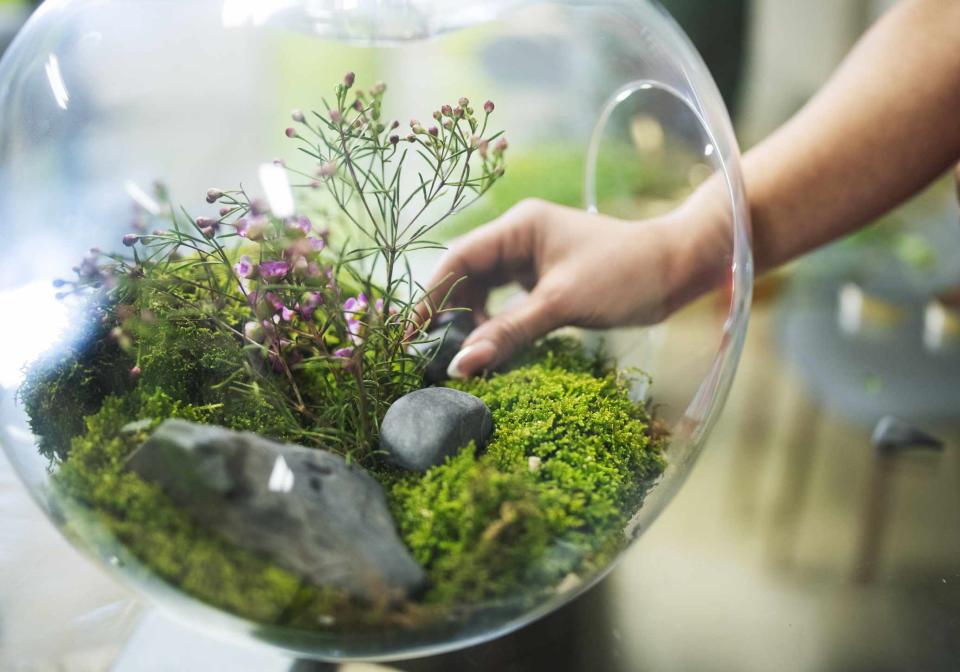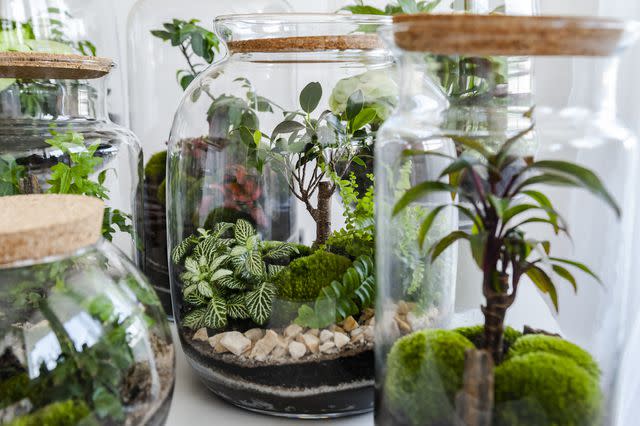How to Make an Easy-to-Grow Moss Terrarium in 7 Simple Steps
Use mosses to create a whimsical fairytale landscape in a glass container

ArtistGNDphotography / Getty Images
Mosses are favored plants for terrariums—unlike any other plants, these slow growers are uniquely suited to create a miniature whimsical landscape with rolling hills, dense forests, or wild savannahs in a glass vessel. The choices among the more than 12,000 species of mosses worldwide are virtually unlimited.
Here’s what need to know about building a moss terrarium, the mosses that work best, and how to maintain your mossarium.
What Is a Terrarium Ecosystem?
A terrarium is an enclosed ecosystem where the plants—in this case, mosses—absorb water and nutrients from the growing substrate.
Through the process of transpiration, evaporation, and condensation, the water is returned to the soil in a continuous self-sustaining cycle, and nutrients are returned to the soil through the natural decay of dead plant parts. There is no need to fertilize the plants in a terrarium.
Want more gardening tips? Sign up for our free gardening newsletter for our best-growing tips, troubleshooting hacks, and more!
Best Mosses for Terrariums
Low-growing mosses work best for terrariums. Here are a few popular varieties used for terrariums:
Cushion moss (Leucobryum glaucum) grows like a puffy pillow, which makes it a favorite moss to create hillside effects and miniature “shrubbery” in your terrarium.
Fern moss (Thuidium delicatulum) has finely textured leaves that resemble fern fronds. In a terrarium, it looks like a miniature forest.
Mood moss (Dicranum scoparium) is a clumpy moss that grows in thick, wavy green tufts. It is great to fill large gaps or bare spots.
Hypnum moss (Hypnum cupressiforme) is a low-growing moss perfect to line the bottom of a terrarium like a wall-to-wall carpet.
Tree moss (Climacium dendroides) has finely textured, dense green foliage that looks like miniature evergreen trees.
Feather moss (Ptilium crista-castrensis) is a low-growing moss whose thin, feathery clumps works well as a groundcover.
How to Make a Moss Terrarium

qnula / Getty Images
Get your terrarium glassware ready. Select a glass container that retains humidity and at the same time gives you easy access. Mosses dry out quickly when out in the open, so the terrarium needs to be enclosed but not hermetically sealed to allow air circulation. A container with a lid is usually preferable over one with a narrow entry.
Add substrate to the terrarium. You can buy premade terrarium substrate or make your own from sterile potting mix (make sure it does not have any fertilizer added) and activated charcoal. Adding the latter into the substrate is practiced to bind any toxins in the water or soil and absorb any odors. Unlike terrarium plants with deeper roots, moss terrariums don’t require a thick layer of ed substrate, just enough for the moss to attach to.
Design the landscape. Sculpt the substrate into your desired topography with hills and mounds. Once you’re satisfied with the way it looks, add hardscaping (stones, driftwood). Place the largest elements at the back and the smaller ones at the front.
Prepare the moss. Place the moss in a bowl of water and soak it thoroughly between 10 and 30 minutes. This not only hydrates the moss but also sends any insects and other living organisms running.
Plant the moss. Place the moss where you want it and gently push it into the substrate. When placing pieces of moss along the outside of the glass vessel, tuck the unsightly rhizoids (the roots of the moss) inwards so they are not in plain view.
Do a final cleanup. Dislodge any dirt clinging to the inside glass sides of your container and wipe them clean with newspaper or paper towel.
Spray with water. Since you have thoroughly soaked the mosses before planting, the mosses will only need a light spraying with water to remove any air pockets.
5 Tips for Maintaining Your Terrarium
Watering: While mosses like moisture, they should never be overwatered. Before watering, always touch the surface of the moss and any open soil areas to see if they feel dry. If your tap water is chlorinated, use filtered or purified water.
Light: Place the moss terrarium in a location with indirect light and never in direct sunlight. A spot about 3 to 4 feet away from a window is ideal. While mosses prefer shady locations in nature, a dark corner indoors does not provide them with enough light.
Temperature: Make sure that you don’t overheat your terrarium and keep it away from heat sources such as radiators and electrical appliances, A room temperature around 74° F is ideal.
Air circulation: In addition to removing the lid when you water the moss, remove it when condensation builds up below the lid and on the walls of the terrarium. Leave the lid off until the condensation disappears.
Pruning: Most mosses grow very slowly and won’t ever get out of hand but if a moss outgrows its allocated space, use scissors to prune the excess growth. Also remove any dead plant parts.
Frequently Asked Questions
How long do moss terrariums last?
With proper care, a moss terrarium can last for years. Two to three years is a good average.
How do I keep moss alive in my terrarium?
Moss is undemanding and you should keep it alive by giving it a spot in indirect light, just the right amount of moisture, and sufficient air circulation to prevent mold inside the terrarium.
How do I make a moss terrarium?
Put a layer of a well-draining substrate (potting mix and activated charcoal) in a glass container with a lid and use mosses of different heights, textures, and shades to design a miniature landscape.
Read the original article on The Spruce.

